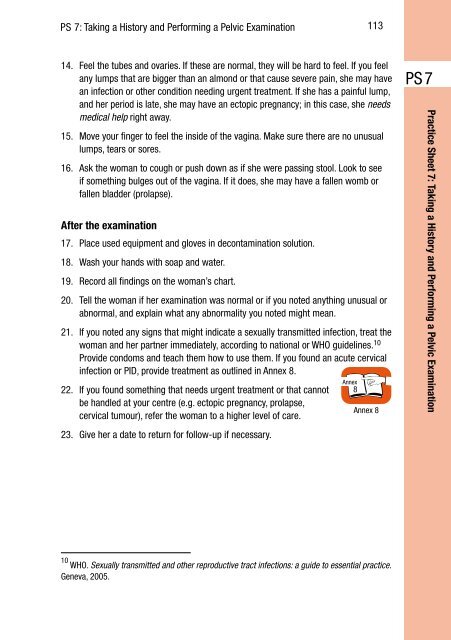CHAPTER 4: SCREENING FOR CERVICAL CANCER
CHAPTER 4: SCREENING FOR CERVICAL CANCER
CHAPTER 4: SCREENING FOR CERVICAL CANCER
Create successful ePaper yourself
Turn your PDF publications into a flip-book with our unique Google optimized e-Paper software.
PS 7: Taking a History and Performing a Pelvic Examination11314. Feel the tubes and ovaries. If these are normal, they will be hard to feel. If you feelany lumps that are bigger than an almond or that cause severe pain, she may havean infection or other condition needing urgent treatment. If she has a painful lump,and her period is late, she may have an ectopic pregnancy; in this case, she needsmedical help right away.15. Move your finger to feel the inside of the vagina. Make sure there are no unusuallumps, tears or sores.16. Ask the woman to cough or push down as if she were passing stool. Look to seeif something bulges out of the vagina. If it does, she may have a fallen womb orfallen bladder (prolapse).After the examination17. Place used equipment and gloves in decontamination solution.18. Wash your hands with soap and water.19. Record all findings on the woman’s chart.20. Tell the woman if her examination was normal or if you noted anything unusual orabnormal, and explain what any abnormality you noted might mean.21. If you noted any signs that might indicate a sexually transmitted infection, treat thewoman and her partner immediately, according to national or WHO guidelines. 10Provide condoms and teach them how to use them. If you found an acute cervicalinfection or PID, provide treatment as outlined in Annex 8.22. If you found something that needs urgent treatment or that cannotbe handled at your centre (e.g. ectopic pregnancy, prolapse,cervical tumour), refer the woman to a higher level of care.23. Give her a date to return for follow-up if necessary.Annex8Annex 8PS 7Practice Sheet 7: Taking a History and Performing a Pelvic Examination10 WHO. Sexually transmitted and other reproductive tract infections: a guide to essential practice.Geneva, 2005.
















